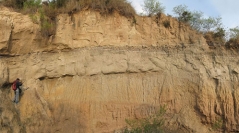

 Comptes Rendus Palevol
15 (3-4) - Pages 440-452
Comptes Rendus Palevol
15 (3-4) - Pages 440-452The Quranwala zone (Siwalik Range, NW India) is known for its Late Pliocene vertebrates. Since 2008, cut marks and stone tools have been collected from Masol. The sedimentary series belongs to the Subathu sub-basin. These sub-Himalayan deposits contain repetitive sequences (∼170 m thick) of silt/clays and sandstones corresponding to the cyclical influx of detrital material in a fluvial environment. Particular features of lithological units allow identification of the stratigraphic position of different paleonto-archeological localities. A first pale environmental reconstruction was enabled by analysis of clay and magnetic minerals. Iron minerals such as haematite and goethite indicate dominant oxic conditions during and after deposition. Clay minerals are of detrital origin, and were supplied from Himalaya by rivers. Illite, the result of physical weathering, is dominant. Smectite present in the lower part of the sequence, was probably supplied from Lesser Himalaya (Suresh et al., 2004). Its presence suggests that the studied area was still a paleo-drainage area for major river(s) during the time considered here.
Upper Siwalik , Pliocène, Anticlinal de Chandigarh, Site paléonto-archéologique de Mazol, Minéraux argileux, Sous-bassin de Subathu, Paléoenvironnement, Ligne de partage des eaux